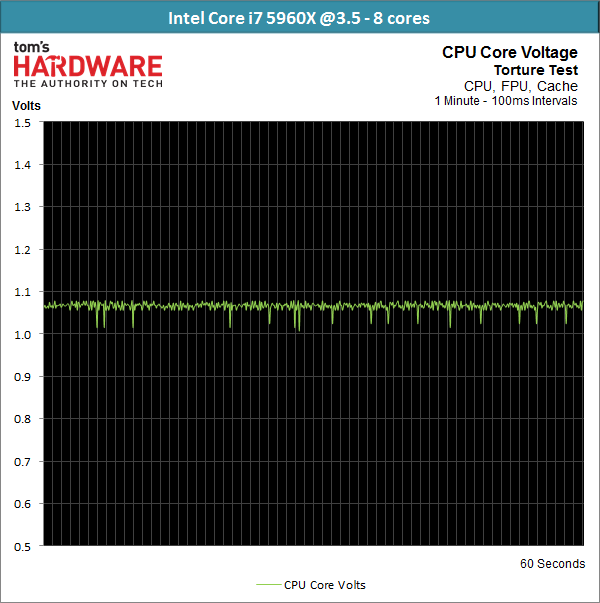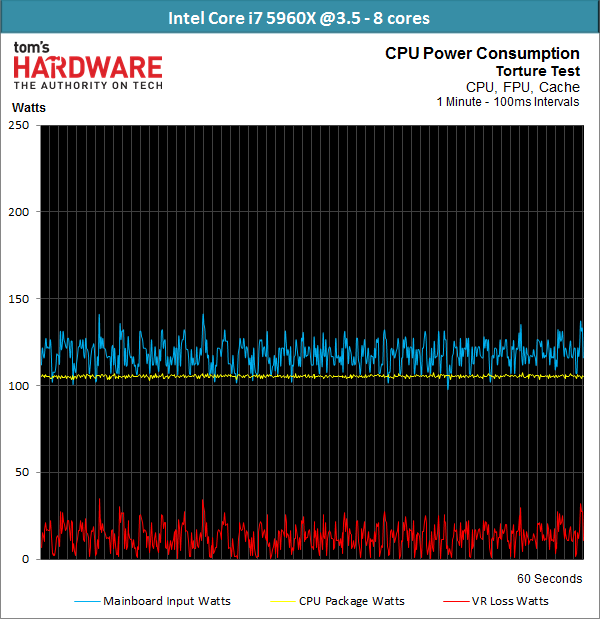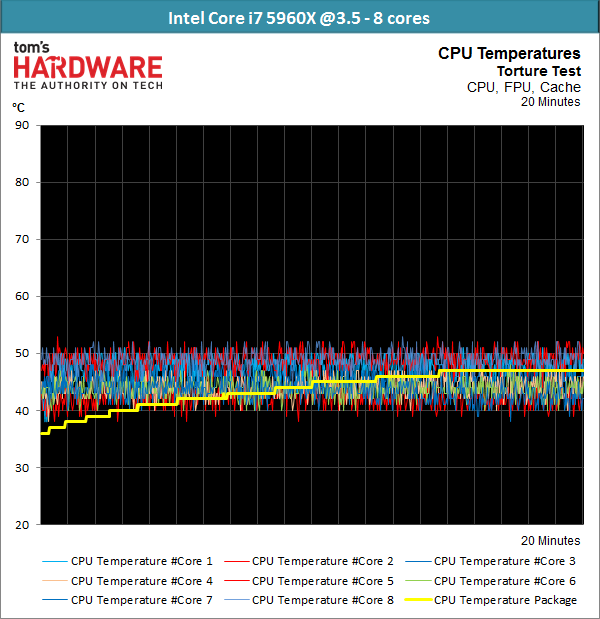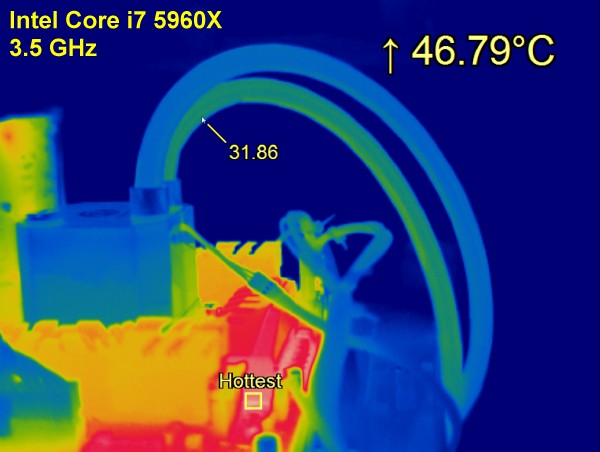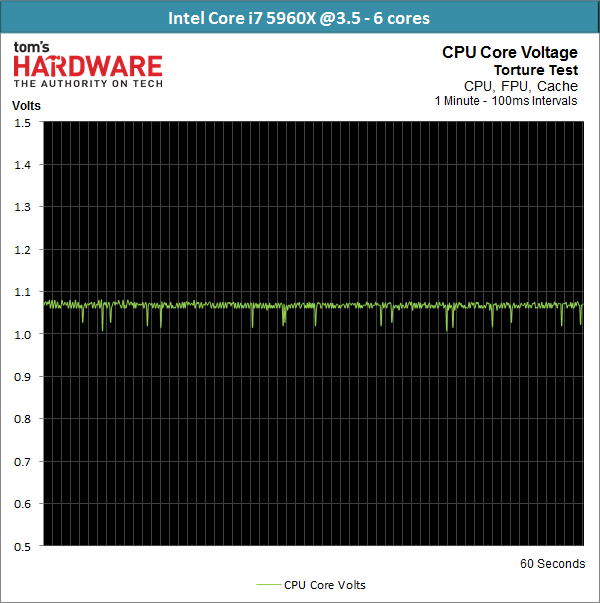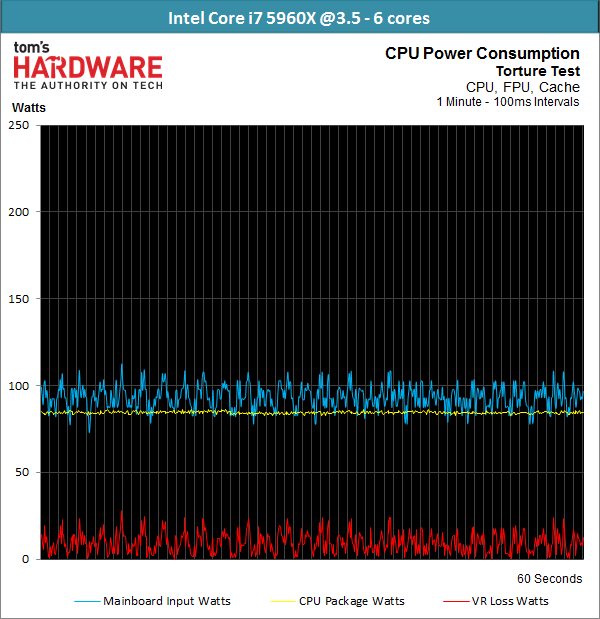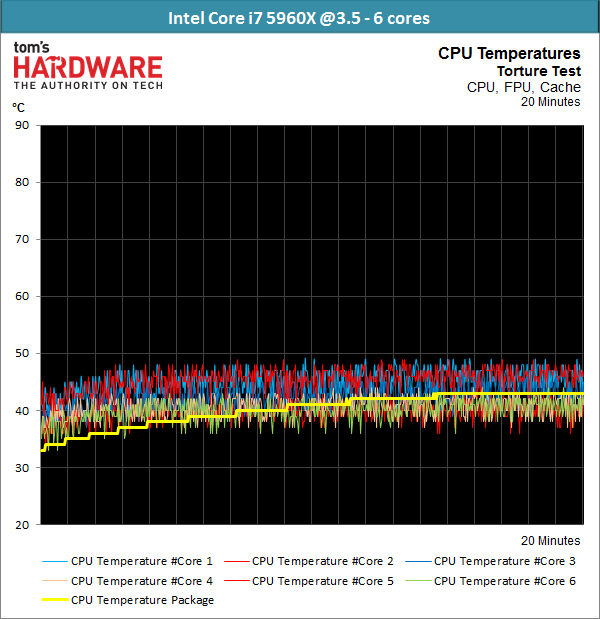Intel Core i7-5960X, -5930K And -5820K CPU Review: Haswell-E Rises
Power, In Depth: Eight and Six Cores at 3.5 GHz
We begin with core voltage again, which climbs to an average of 1.066 V compared to the stock frequency. That's the motherboard's automatic response to elevated demands; we didn’t manually adjust the firmware's voltage setting.
Power Draw
We again compare the values from the VRM sensor to those measured in parallel at the motherboard input, calculating the losses.
An idle measurement of 18 W (that's 22 W, counting losses) and load reading of 108 W (or 121 W with losses added in) at 3.5 GHz is perfectly acceptable for a processor rated at 140 W.
| Power Consumption | Average Idle | Maximum, 100% Load | Average, 100% Load |
|---|---|---|---|
| CPU 12 V In | 22 W | 141 W | 121 W |
| CPU Package | 18 W | 110 W | 108 W |
| VRM Loss | 4 W | 31 W | 13 W |
Temperatures
Naturally, our thermal readings are low at idle. Under load, they look like this:
Let’s take a look at the time-lapse video, too.
| Temperature T | Idle | Maximum, 100% Load | Average, 100% Load (Heated Up) |
|---|---|---|---|
| Core | 27 °C | 53 °C | 45 °C |
| Package | 29 °C | 46 °C | Row 1 - Cell 3 |
| Water (In / Out) | 24 °C / 27 °C | 32 °C | Row 2 - Cell 3 |
| VRM | 34 °C | 47 °C | Row 3 - Cell 3 |
Six Cores At 3.5 GHz
Since our Core i7-5930K was in California with Chris, Igor deactivated two cores on his -5960X and adjusted his maximum Turbo Boost frequency to match the second-fastest Haswell-E processor. The CPUs are practically identical apart from the somewhat smaller cache, so the results should be comparable.
Core Voltage
A 1.072 V core voltage is a bit higher than before due to the higher Turbo Boost clock rate.
Get Tom's Hardware's best news and in-depth reviews, straight to your inbox.
Power Draw
Once again, the values from the VR sensor are compared to those measured in parallel at the motherboard input, and the losses are calculated.
A reading of 16 W (with voltage regulator losses, 20 W) at idle and 84 W (with VR losses, 94 W) under load, the six-core adaptation uses a bit less power.
| Power Consumption | Average, Idle | Maximum, 100% Load | Average, 100% Load |
|---|---|---|---|
| CPU 12 V In | 20 W | 113 W | 94 W |
| CPU Package | 16 W | 86 W | 84 W |
| VRM Loss | 4 W | 27 W | 10 W |
Temperatures
Our thermal measurements under load yield the following chart:
| Temperature T | Idle | Maximum, 100% Load | Average, 100% Load (Heated Up) |
|---|---|---|---|
| Core | 27 °C | 48 °C | 43 °C |
| Package | 28 °C | 43 °C | Row 1 - Cell 3 |
| Water (In / Out) | 24 °C / 27 °C | 31 °C | Row 2 - Cell 3 |
| VRM | 33 °C | 44 °C | Row 3 - Cell 3 |
At 3.5 GHz, both CPUs (but especially the six-core configuration) give us a good impression of an architecture we might not have expected to fare as well. Haswell-E is emerging as a solid foundation for a gaming machine that can be cooled well using air or liquid.
Current page: Power, In Depth: Eight and Six Cores at 3.5 GHz
Prev Page Power, In Depth: Stock Clock Rates Next Page Power, In Depth: Eight and Six Cores at 4 GHz-
B4vB5 Chris and Igor @ TomsHW,Reply
Bit disappointed to not see a comparison with the Xeon E5-1650v2(or 1660v2), as the 2600 is a bit overkill comparing prices. Some of us just need a workstation with ECC ram and not just a free-for-all(ie someone else is paying) Xeon 2600 fest. -
JamesSneed Out of curiosity why were so many of the gaming tests only done at 2560x1440? Seems like you would be more GPU bound at this resolution. I'm not sure it really matters but I do like gaming at 1080p for the very high frame rates was curious if these would push frame rates higher. Otherwise nice review.Reply -
ohim Reply14063555 said:Affordable 8-cores from Intel are finally coming. Awesome.
1000$ is affordable to you ? :))
14063653 said:Out of curiosity why were so many of the gaming tests only done at 2560x1440? Seems like you would be more GPU bound at this resolution. I'm not sure it really matters but I do like gaming at 1080p for the very high frame rates was curious if these would push frame rates higher. Otherwise nice review.
Though you have a point here, the guy buying such CPUs most likely will game at above 1080p .. but this would have implied using 2 GPUs at least in the test. -
chiefpiggy Why do they call these their "5th generation" of Intel core processors if they're refreshes of the Haswell processors? I get that they have revolutionary technology within but with the release of broadwell so soon I doubt that anyone would buy these processors..Reply -
envy14tpe I need this system to play Minecraft. with that aside, Intel finally has made a jump in i7s value and performance.Reply -
srap "Single-threaded software is so last decade, though."Reply
I have a hunch that we will never see anything like this in the comment sections of AMD reviews. Not sure why :D -
CaptainTom Yeah the real winner of a cpu here is definitely the 5820K. If I were building now, that is what I would use.Reply
